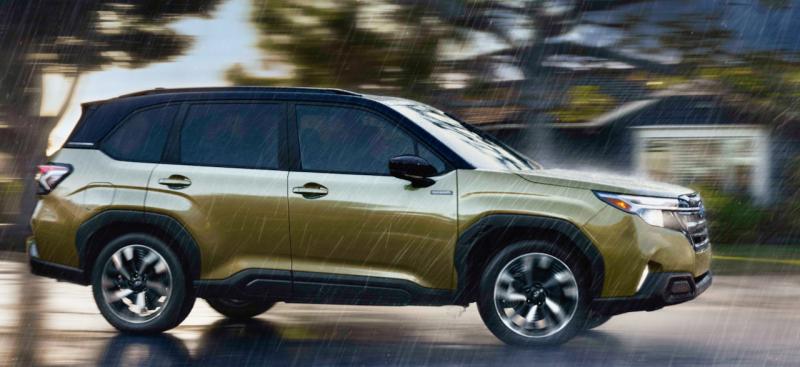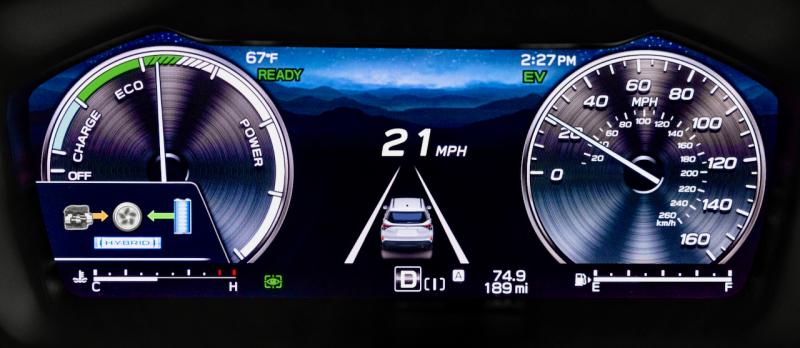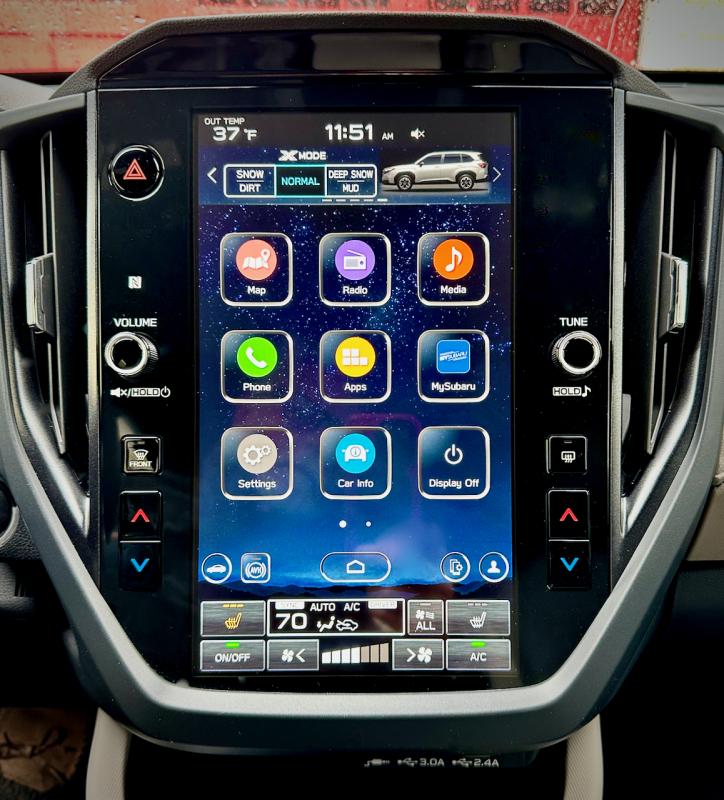The un-SUV: Subaru Forester Premium Hybrid
 A new hybrid drivetrain smooths out the Forester’s performance and improves fuel efficiency while reducing emissions. For 2025, the Forester became the handsomest vehicle in Subaru’s stable while retaining its practical nature—with 8.7 inches of ground clearance, it stands taller than some ‘real’ SUVs, but getting in and out is easy.
A new hybrid drivetrain smooths out the Forester’s performance and improves fuel efficiency while reducing emissions. For 2025, the Forester became the handsomest vehicle in Subaru’s stable while retaining its practical nature—with 8.7 inches of ground clearance, it stands taller than some ‘real’ SUVs, but getting in and out is easy.
 Because of its drivetrain, the hybrid Forester’s driver’s display is different from the gas-only Forester’s. The main computer also offers hybrid-only screens.
Because of its drivetrain, the hybrid Forester’s driver’s display is different from the gas-only Forester’s. The main computer also offers hybrid-only screens.
 There’s a lot going on here. The 2025 Forester Premium has a near-luxury interior, too with new seats, dashboard, consoles and steering wheel that are more comfortable, adjustable, plush and pleasing to the touch.
There’s a lot going on here. The 2025 Forester Premium has a near-luxury interior, too with new seats, dashboard, consoles and steering wheel that are more comfortable, adjustable, plush and pleasing to the touch.
 A new hybrid drivetrain smooths out the Forester’s performance and improves fuel efficiency while reducing emissions. For 2025, the Forester became the handsomest vehicle in Subaru’s stable while retaining its practical nature—with 8.7 inches of ground clearance, it stands taller than some ‘real’ SUVs, but getting in and out is easy.
A new hybrid drivetrain smooths out the Forester’s performance and improves fuel efficiency while reducing emissions. For 2025, the Forester became the handsomest vehicle in Subaru’s stable while retaining its practical nature—with 8.7 inches of ground clearance, it stands taller than some ‘real’ SUVs, but getting in and out is easy.
 Because of its drivetrain, the hybrid Forester’s driver’s display is different from the gas-only Forester’s. The main computer also offers hybrid-only screens.
Because of its drivetrain, the hybrid Forester’s driver’s display is different from the gas-only Forester’s. The main computer also offers hybrid-only screens.
 There’s a lot going on here. The 2025 Forester Premium has a near-luxury interior, too with new seats, dashboard, consoles and steering wheel that are more comfortable, adjustable, plush and pleasing to the touch.
There’s a lot going on here. The 2025 Forester Premium has a near-luxury interior, too with new seats, dashboard, consoles and steering wheel that are more comfortable, adjustable, plush and pleasing to the touch.
When we reviewed the 2025 Subaru Forester last July, we called it “radically different-looking, at least for Subaru,” and noted that its cabin is “no longer forgettably dowdy or, digitally speaking, indifferently functional.” In fact, the Forester Premium’s new 12-inch-diagonal Starlink touchscreen offers an astonishing menu of features and adjustments.
For example, not only will this Forester remind us of birthdays and anniversaries, it lets us vary the rate of acceleration of its adaptive cruise-control system—from eco to comfort to normal and then dynamic. The headlights can be set to turn with the front wheels. Three sets of driver’s preferences can be stored. And, in a bizarre pairing, not only are there inclinometers, to show the tilt angles while off-road (where virtually no Forester Hybrid will go), there’s also a valet mode, which is normally found only on high-performance cars, to prevent other drivers from unleashing gobs of power.
This is not a high-performance car. The normal Forester’s 2.5-litre flat-four gas engine delivers 180 horsepower and 178 pound-feet of torque. With electric assistance, the Hybrid can muster 194 horses and 199 torques. (Subaru, you couldn’t nudge this past 200HP, just for bragging rights?) The difference shows up in two places: Acceleration from a stop is stronger, thanks to immediate electric power; and fuel efficiency improves from the gas model’s upper 20s to about 35 MPG.
But there are other improvements, too. The Forester Hybrid has a new three-motor drivetrain developed together with Toyota. In parallel with the gasoline engine there are two electric motors. The one that does the driving resides inside the transmission housing, not on the rear axle. This means it’s always sending power through Subaru’s full-time Symmetrical All-Wheel Drive, not just when an algorithm decides the rear wheels need help. The second e-motor is a starter-generator that fires up the gas engine and then recharges the lithium-ion battery that powers the drive motor, so no traction power has to be diverted to the batteries.
Like the normal Forester, the hybrid has a continuously variable automatic transmission, but this one has real gears rather than pulleys and belts, and consequently operates more smoothly. Along with extra sound-deadening, the new drivetrain reportedly makes the hybrid quieter than the un-assisted Forester, which is already the quietest Forester yet.
One of the Forester’s hallmarks is a huge greenhouse—that is, its windows are relatively large, so we feel like we’re in a penthouse apartment. Unfortunately, Subaru doesn’t allow us the full benefit of this panoramic view. Driving a Forester makes me feel like I’m sitting in a hole; I want to raise the seat another two or three inches beyond its stop, which would improve my field of view all around and still leave a handspan of headroom before bumping up against the enormous sunroof.
If, like so many folks in northern New England, you’re hoping to squeeze another 100,000 miles out of a Subie that’s 15 years old, the 2025 Forester will astonish you. (Really, any brand-new car will.) For starters, there’s the latest generation of the company’s EyeSight safety system, which uses binocular vision to keep an eye on traffic and steps in to help the driver when necessary.
EyeSight is now standard on all Forester models, but this Premium trim includes features and conveniences that only luxury cars had 15 years ago, yet sticker shock—part and parcel of any new-car purchase now—is relatively mild. Even with hybrid drive, our Premium barely clears $36,000. This is only about 6 grand more than a base level non-hybrid Forester, but if neither of these fills the bill, there are now eight other trim levels to choose from.
Next week: Acura RDX A-Spec


























